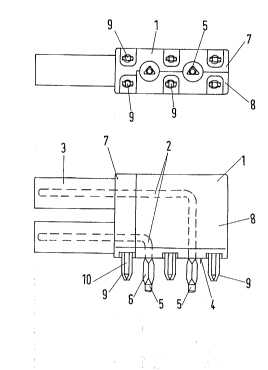Note: Descriptions are shown in the official language in which they were submitted.
` 1 21 80489
Electrical connector
The invention relates to an electrical connector for assembly on printed-
circuit boards, having a single- or multi-part housing which contains and
o screens contact elements of the connector, and having means of connectingthe housing in an ele.,~ "y conductive manner to the printed-circuit board.
Such co,~,~eulu, ~, particularly when they are provided with coaxial contacts,
have to have a screen in order to prevent extemal disturbing pulses from
reaching the contact elements inside the u~ eulol and to prevent outward
emission of pulses which are carried through the contact elements.
It is known to provide electrical w, " ,e,.lu~ ~ with a conductive housing, which
contains the contact elements and is used to retain and screen said contact
elements. The contact elements comprise solder pins or press-in pins,
which project from one side of the housing and are insertable into holes of a
printed-circuit board. For the electrically conductive cu""eulioll of the
housing to the printed-circuit board, a sheet metal part is provided which is
fastened (riveted) to the housing and uu~ Jrises pins which are insertable
into plated holes of the printed-circuit board. In said case, however, manu-
facture of another component in addition to the housing is required.
The object of the invention is to construct an electrical co",~lu, of the type
described initially in such a way that it may be manufactured inexpensively.
_ .
Said object is achieved in that the housing takes the form of an injection-
moulded part and is electrically conductive, and that pins integrally formed
on the side of the housing ~acing the printed-circuit board are provided,
2 1 $0489
2
which are insertable into holes of the printed-circuit board and connectable
to printed conductors of the printed-circuit board.
Advantageous, tri~lel1 le~ of the inYention are indicated in claims 2 to 5.
The advantages achieved by the invention are in particular that, by virtue of
integrally forming the solder or press-in pins on the housing preferably
manufactured as an injection-moulded part, there is no need for an addi-
tional cu" ,~ e"~ for e ,ld~l;sl li~)g the electrical connection of the housing to
o the printed-circuit board. In said respect, a further advantage is that contact-
ing problems (contact resistance of co,~,~e~iol1 points) between the connec-
tion of the additional c~",pu,)e"l to the housing are also eliminated.
A further advantage, given the use of a high-purity zinc casting alloy as a
housing material, is that said material has an excellent electric conductivity
and so a reduction of the electrical housing It:si~la~ is achieved.
An embodiment of the invention is illustrated in the drawings and described
below in detail.
The drawings show:
Fig. 1 a view of a connector,
Fig. 2 the side view of the connector according to Fig. 1, and
Fig. 3 the bottom view of the connector according to Fig. 1.
The connector illustrated in Figs. 1 to 3 substantially comprises a housing 1,
in which contact elements 2 are held. The contact elements take the form of
coaxial contacts and, at the left side of the connector, tubular screening
sleeves 3 are disposed over the contact elements and fastened conductively
in or to the housing. Projecting from the underside 4, i.e. from the side of the
2 1 804~9
3
housin3 directed towards the printed-circuit board, are terminals 5 of the
contact elements. Said terminals are provided with a press-in portion 6
which may be pressed into holes of a printed-circuit board which is not
shown in detail here.
s
The housing 1 of the connector is preferably made of a high-purity zinccasting alloy such as, for example, GD-ZnAi4Cu1 according to DIN 1743,
Part 2, and comprises two half shells 7, 8. The contact elements 2 are held
in said housing by means of spacers made of insulating material, which are
~o not shown in detail here. The housing or the half shells are manufactured as
injection-moulded parts and are provided at the underside with integrally
fonmed pins 9. The pins, which during assembly of the ~or,,~e~ul on the
printed-circuit board engage into plated holes, take the form of solder or
press-in pins, the press-in pins being provided with a press-in portion 10.
The press-in portion may comprise a rigid or, optionally, elastic press-in
zone.
The housing or the half shells may optionally be made of plastic material and
provided with a conductive coating - metallic coating.
